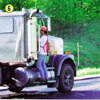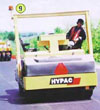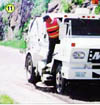

Safety Is For Life - Yours!
by John S. Ball
 A safety program should be looked at as a commitment from three segments of the organization. Each group has its own set of ideas about safety, and if the contracting company can draw from them, the company's safety program will be that much stronger.
A safety program should be looked at as a commitment from three segments of the organization. Each group has its own set of ideas about safety, and if the contracting company can draw from them, the company's safety program will be that much stronger.
The first segment of the safety trio is the company. What is the company's safety policy and how committed is it to its safety program? The company should be 100 percent committed, and its employees 110 percent committed to the company safety policy. Employees must buy into the company's safety program. Why be safe? Because it's not just a matter of risk to the employee, but also the risk of the company. One too many unsafe practices and there won't be a company to work for.
The second segment of the safety commitment is the employee. How committed is your employee to your company's safety program? Does the company practice a buddy system and does the employee look out for his co-workers? Does he equip himself with stilted shoes, eye goggles, hearing protection, a safety vest and/or gloves? Does he wear vibrant colored shirts and pants for high visibility?
What is the attitude of the employee versus the employer when it comes to safety? We often hear in the field from the new guy, "How's it going out here? Where does the company stand on safety?"
Sometimes we hear, "Oh, they don't give a flip about our safety..." as a response. If the company's safety program falls down, it's because the employees and employer allow it to. If you as an employee are committed, your company's safety program will work. Employees are the nucleus of the company and the nucleus of the company's safety program.
The third segment of the safety commitment trio is the equipment manufacturer. Manufacturers build the equipment which is the bloodline of the company. But they build these units with bells and whistles, such as operating and safety features, that take some education to operate correctly. Do manufacturers' reps go to their customers and introduce the safety features of the equipment?
How committed is the manufacturer to supporting the customer in the area of safety? Pinch features, augers, extend-a-mats: Do manufacturers post signs indicating these are hot spots? Equipment is more sophisticated these days. Is the sales department responding to that by going out with every product to explain its correct operation? Whether it's one fatality or one broken fingernail, it can put a bad name on the manufacturer.
Safety programs should match company personality, so, what kind of safety program does your company offer? Some companies offer incentive programs, where the company is divided into teams which compete with each other for the least number of accidents in a certain period of time. Incentive programs do work as long as the carrot is not extended too far.
First of all, the company should allow employees to buy into the safety program. Employees should be allowed to formulate their own goals. If management alone sets up the program, chances are it won't work. Second, safety program goals should be attainable. And when the goal is reached, the company should bring the team back into the office for feedback and recognition. Employees should be personally rewarded for safe practices with a handshake and a thank you. Then they should receive some kind of safety award, whether it's a monetary bonus, a gift certificate for a family outing, a belt buckle, or a jacket with the company name in big bold letters across the back and a slogan that says something to the effect of, "Number one in safety."
Third, once the safety program is in place and a success, the company should stick with it and add to it on a regular basis. And, the program should be practical. Say Tom, the division manager in charge of safety, goes out in the field and sees a crew member running in front of the paver as the truck backs up on the hopper. He says to himself, "I have to remember to tell the foreman, Bob, I saw Pete run in front of the paver. That's bad business." But it's Friday afternoon, and foreman Bob has left for the day, so Tom decides to wait until next week to bring the issue to Bob's attention. That's bad safety practice.
Instead, the safety director should address the problem as he sees it happen. Tom should go up to Pete, stop the process, and explain to Pete what he has done wrong. And Tom shouldn't only criticize, but find something to commend Pete for as he explains the problem.
What goes wrong and why
| Why do incidents happen? Several reasons are: people are in a hurry to get the job done, they are tired from working a long day, and they are concentrating on reaching the end of the chore and not on the task at hand. The bottom line is we all have to be awake and alert at all times on the job. Safety is merely common sense. Here are some examples of good and bad safety practices. Remember, these incidents were all staged for the benefit of this article: |
 Photo No. 1: The guy is standing in front of the hopper. This is the top accident scenario in paving and, unfortunately, accounts for the most crushes and fatalities. This is the worst place he can be. If nobody sees him, he could be gone in a second. It's the beginning of the day, and the ground man is waiting for the truck to enter the work zone. Photo No. 1: The guy is standing in front of the hopper. This is the top accident scenario in paving and, unfortunately, accounts for the most crushes and fatalities. This is the worst place he can be. If nobody sees him, he could be gone in a second. It's the beginning of the day, and the ground man is waiting for the truck to enter the work zone.
First, the ground man, who choreographs the whole paving process, should be standing to the right of the paver hopper, away from the work path. He should not be standing in the milled area at all. Second, think of the dimensions of the truck and material transfer vehicle hopper. The truck has an 8 foot (2.4 meter) bed and the MTV has a 10 foot (3 meter) hopper. That leaves absolutely no room for a person standing in the way. Finally, the ground person, or truck dumper, should be looking directly in the truck's direction so his vest is illuminated for the truck driver. And, because he is all places at all times, he should be dressed in vibrant colors so everyone involved in the process can spot him at all times. |
 Photo No. 2: This is an example of another bad practice - that of the supervisor driving down the road with his foot handing out the door. We all know what could happed if his foot gets caught on something in the road, or gets dragged along with milled surface. Photo No. 2: This is an example of another bad practice - that of the supervisor driving down the road with his foot handing out the door. We all know what could happed if his foot gets caught on something in the road, or gets dragged along with milled surface. |
 Photo No. 3: This crew member is sweeping hot mix spilled from the MTV as the unit travels down the road conveying hot mix above his head to the paver hopper. He is standing on the blind side of the paving train, underneath moving equipment. Look at the flagperson - she doesn't even see him from her vantage point. Photo No. 3: This crew member is sweeping hot mix spilled from the MTV as the unit travels down the road conveying hot mix above his head to the paver hopper. He is standing on the blind side of the paving train, underneath moving equipment. Look at the flagperson - she doesn't even see him from her vantage point. |
 Photo No. 4: This is an example of how not to come down off a moving paver. This gentleman is coming down off the catwalk in a hurry. He has one hand on the railing and one foot on the step. A sudden jolt could catapult him onto the hot pavement. Instead, as Photo No. 5 shows, the rule for climbing on and off equipment is two feet, one hand, or even better, two hands, one foot. Plus, this roller operator is equipped with a fluorescent vest and hearing protection Photo No. 4: This is an example of how not to come down off a moving paver. This gentleman is coming down off the catwalk in a hurry. He has one hand on the railing and one foot on the step. A sudden jolt could catapult him onto the hot pavement. Instead, as Photo No. 5 shows, the rule for climbing on and off equipment is two feet, one hand, or even better, two hands, one foot. Plus, this roller operator is equipped with a fluorescent vest and hearing protection |
 Photo No. 6: The photo shows the second-worst accident waiting to happen in the paving industry. This crew member, although dressed in his safety vest, is standing on the running board of the dump truck -whose bed is up by the way - jawing with the truck driver. Not only is he distracting the driver, he is positioned on the blind side of the paving train and is not visible to other equipment operators. It has happened where a whole load of hot asphalt was dumped in front of the paver because the driver was distracted in a situation just like this one. Photo No. 6: The photo shows the second-worst accident waiting to happen in the paving industry. This crew member, although dressed in his safety vest, is standing on the running board of the dump truck -whose bed is up by the way - jawing with the truck driver. Not only is he distracting the driver, he is positioned on the blind side of the paving train and is not visible to other equipment operators. It has happened where a whole load of hot asphalt was dumped in front of the paver because the driver was distracted in a situation just like this one. |
 Photo No. 7: The two back end guys, well-dressed in their fluorescent vests, are setting gup automatic grade and slope controls on the paver. But, unfortunately, they are situated in the live auger area. The operator, positioned above, may not see the guy who is bending down to make the adjustments. As the paver is loaded, this back end guy could be burned as the operator charges the screed with live material, or pinched as the screed extensions are adjusted. Photo No. 7: The two back end guys, well-dressed in their fluorescent vests, are setting gup automatic grade and slope controls on the paver. But, unfortunately, they are situated in the live auger area. The operator, positioned above, may not see the guy who is bending down to make the adjustments. As the paver is loaded, this back end guy could be burned as the operator charges the screed with live material, or pinched as the screed extensions are adjusted. |
 Photo No. 8: The two guys dragging the ski are hauling a heavy object and are doing so in the high-speed lane with traffic whizzing past the work zone. They can't see the traffic approaching them from behind, so they could get clipped and injured. Plus, where is the flag person? Photo No. 8: The two guys dragging the ski are hauling a heavy object and are doing so in the high-speed lane with traffic whizzing past the work zone. They can't see the traffic approaching them from behind, so they could get clipped and injured. Plus, where is the flag person? |
 Photo No. 9: This is an example of good safety practice. This contractor has added the farm vehicle decal to the front of this roller and the strobe light on the top of the ROP's. You will see more and more of these decals, indicating the vehicle travels at 15 mph (24 kmph), at the paving site. It makes sense. Photo No. 9: This is an example of good safety practice. This contractor has added the farm vehicle decal to the front of this roller and the strobe light on the top of the ROP's. You will see more and more of these decals, indicating the vehicle travels at 15 mph (24 kmph), at the paving site. It makes sense. |
 Photo No. 10: This depicts good safety practice. This roller operator is wearing his safety vest and hearing protection and his roller is equipped with the TOPs feature. TOPs supports the weight of the machine so that if the compactor should roll over, the operator is protected from injury - if the operator is wearing a seatbelt. And some operators do not always wear their seatbelts because they are constantly moving wishing their seats, looking in different directions, adjusting perspective and/or signaling to other operators wear their seatbelts. And, some states will fine contractors for seatbelt infractions. Photo No. 10: This depicts good safety practice. This roller operator is wearing his safety vest and hearing protection and his roller is equipped with the TOPs feature. TOPs supports the weight of the machine so that if the compactor should roll over, the operator is protected from injury - if the operator is wearing a seatbelt. And some operators do not always wear their seatbelts because they are constantly moving wishing their seats, looking in different directions, adjusting perspective and/or signaling to other operators wear their seatbelts. And, some states will fine contractors for seatbelt infractions. |
 Photo No. 11: This depicts a sweeper equipped with two operating stations in the cab, yet the operator is hanging out the door as he drives the sweeper. The sweeper could hit a snag in the road, and the operator could fall off or be catapulted across the work area. Not good practice. Photo No. 11: This depicts a sweeper equipped with two operating stations in the cab, yet the operator is hanging out the door as he drives the sweeper. The sweeper could hit a snag in the road, and the operator could fall off or be catapulted across the work area. Not good practice. |
 Photo No. 12: Here are three truck drivers. Their truck beds are equipped with hug, highly visible signs indicating that traffic should not follow their construction vehicles. But, where are their safety vests? Photo No. 12: Here are three truck drivers. Their truck beds are equipped with hug, highly visible signs indicating that traffic should not follow their construction vehicles. But, where are their safety vests? |
Home | Articles | Qualification | Calculators
Top Quality Paving
PO Box 4398
Manchester, New Hampshire 03108
Cell Phone 603-493-1458
Write to us at our E-mail address for more information
Visit Asphalt Contractor Magazine Online!
WebMaster: Sullivan+Wolf Design, LLC